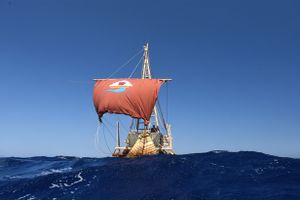Schilffloß ABORA IV in Patara noch intakt
Presseinformation ABORA-Projekt - 13. September 2021 - www.abora.eu
(dg) Nach zwei Jahren Ausstellung im Freien in Patara in der Türkei macht die ABORA IV noch einen recht ordentlichen Eindruck. Das Schilfboot segelte im Jahr 2019 vom bulgarischen Varna durch die beiden türkischen Meeresengen in die Ägäis, um schließlich von Santorin quer zu den Elementen zurück an die lykische Küste nach Kaş zu navigieren. Das Ziel war der experimentelle Nachweis, dass frühgeschichtliche Schilfsegler ab der Jungsteinzeit über diese Routen regelmäßig Fernhandel betrieben.
Am Wochenende erhielt ich eine Bildersammlung des deutschen Archäologen und Leiter der Winkelmann-Gesellschaft Stendal von Prof. Dr. Max Kunze. Er arbeitet seit vielen Jahren mit den türkischen Archäologen zusammen, die auch unser Schilfboot betreuen. Die Bilder stimmen mich optimistisch, dass unser Schilfsegler wenigstens noch ein bis zwei Jahre durchhält.
Der Leser muss bedenken, dass das Schilf für die ABORA IV bereits 2018 am Titikakasee in Bolivien geerntet und erst 2019 in Bulgarien zum Rumpf zusammengeschnürt wurde. Damals hatte es am Ufer des Varnasees ungewöhnlich starke Regelfälle gegeben, die den Bootsbau trotz großer Hilfe durch die Bulgaren negativ beeinflusste. Mit mehr als zwei Monaten Verspätung im Gepäck startete das Schilfboot dann seine mehr 1.550 km lange Seereise. Im Herbst 2019 wurde sie ebenfalls bei ungewöhnlich heftigen Regenfällen geborgen und im Archäologie-Park Patara wieder aufgestellt.
Dank der engen Zusammenarbeit mit Prof. Havva İşkan und ihren Kollegen wird das Schilfboot regelmäßig konserviert und betreut. Die Bilder aus Patara bezeugen, dass der Bootskörper mit den Aufbauten zwar eingesackt, aber strukturell noch intakt ist. So können sich in den nächsten ein bis zwei Jahren noch viele Besucher unser Replika anschauen und die technischen Entwicklungen am Ende der Jungsteinzeit bestaunen. Die Fahrt der ABORA IV hat demonstriert, dass das technische Vermögen der frühen Kulturen sehr groß war. Neuere archäologische Funde untermauern, dass es zwischen Europa, Kleinasien und selbst nach Ägypten einst einen regen Handelsverkehr gegeben haben musste.
Auf der 1.550 km langen Seereise musste das Schilfboot so manches Hindernis durchsegeln. Dabei überstand es auch zwei Starkwindsysteme und bewies dabei seine Hochseetauglichkeit. * The reed boat had to sail through many obstacles on the 1,550 km long sea voyage. It also survived two strong wind systems and thereby proved its suitability for high seas.
Im Kielwasser der „Argonauten der Steinzeit“ konnte ABORA IV sowohl für die bulgarischen als auch türkischen Archäologen viele wichtige Fragen beantworten, die auf dem Festland nicht zu lösen waren. * In the wake of the “Argonauts of the Stone Age”, ABORA IV was able to answer many important questions for both Bulgarian and Turkish archaeologists that could not be solved on the mainland.
Kontakt: Dr. rer. nat. Dominique Görlitz; +49 163 511 57 66 oder dominique.goerlitz*at*t-online.de(bitte "*at*" durch *@* ersetzen, oder, sofern auf Ihrem System möglich, einfach den Link anklicken)
++++++++++++++++++++++++
The reed raft ABORA IV in Patara is still intact
After two years of outdoor exhibition on the Agora of Patara in Turkey, the ABORA IV still makes a pretty good impression. In 2019, the reed boat sailed from Varna in Bulgaria through the two Turkish straits into the Aegean Sea, before finally navigating from Santorini across the elements back to the Lycian coast to Kaş. The aim was to provide experimental evidence that prehistoric reed sailors from the Neolithic period regularly traded long-distance via these routes.
At the weekend I received this picture collection from the German archaeologist and director of the Winkelmann Society in Stendal, Prof. Dr. Max Kunze. For many years he has been working with the Turkish archaeologists who also look after our reed boat. The pictures make me optimistic that our reed swift will hold out for at least another year or two.
The reader must bear in mind that the reeds for the ABORA IV were already harvested in 2018 on Lake Titicaca in Bolivia and only tied to the trunk in Bulgaria in 2019. At that time there were unusually strong cases on the shores of Lake Varna, which had a negative impact on boat building despite great help from the Bulgarians. With a delay of more than two months, the reed boat then started its more than 1,550 km long sea voyage. In autumn 2019, it was also recovered during unusually heavy rainfall and placed back in the Patara Archaeological Park.
Thanks to the close cooperation with Prof. Havva İşkan and her colleagues, the reed boat is regularly preserved and looked after. The pictures from Patara show that the hull with the superstructure is sunk in, but structurally intact. In the next one to two years, many visitors will certainly be able to look at our replica and marvel at the technical developments at the end of the Neolithic. The journey of the ABORA IV demonstrated that the technical ability of the early cultures was higher. Recent archaeological finds confirm that there must have been brisk trade between Europe, Asia Minor and even Egypt.




